When Titanic slipped beneath the unusually calm North Atlantic on the night of April 15th, 1912, the only tangible items of the ship to remain were its sixteen wooden and four collapsible lifeboats. Two of the collapsible lifeboats were never properly launched, with one becoming an upside-down refuge (collapsible B) and the other being partially flooded (collapsible A). Overall, a little over 700 survivors waited in the open sea, exposed in these tiny boats, hoping for rescue.
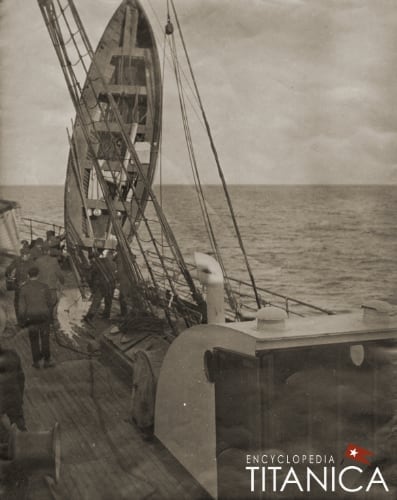
When rescue did arrive, in the form of the SS Carpathia, they not only plucked the survivors from the boats but also took onboard 13 of Titanic's wooden lifeboats while setting the others adrift (not counting the two improperly launched collapsible boats whose occupants had been rescued by other lifeboats during the night). Titanic's wooden lifeboats were numbered 1-16, and taken onboard the Carpathia were lifeboats 1, 2, 3, 5, 6, 7, 8, 9, 10, 11, 12, 13 and 16.
The reason for the other's being set adrift was provided by the Evening World via a statement made by 'crew member' Edward Tufts:
Although all the other survivors were firm in their declaration that only sixteen lifeboats were picked up by the Carpathia, Tufts maintained that eighteen boats in reality reached her.
"Thirteen of these boats were brought in on the Carpathia's davits, while five were cast adrift at sea because there was no room for them," he said.
With these boats and Titanic's survivors in hand, the Carpathia headed towards New York, where it would arrive on the night of April 18th. For the most part, the Carpathia kept radio silence during its voyage, except for the relaying of survivors' names. One survivor being Bruce Ismay, President of the International Mercantile Marine (IMM), the parent of Titanic's flag company, the White Star Line, of which Bruce Ismay was also Managing Director. On April 17th, Carpathia's radio silence would be cut by messages from Bruce Ismay, signed 'Yamsi', to the Vice President of the IMM, Philip Franklin, at the White Star Line's New York office.

(The Philadelphia Inquirer; Sunday, April 21, 1912)
One such message, sent the following day, April 18th, and received at 5:35am, read, "Send responsible ship officer and 14 White Star sailors in two tugboats to take charge of 13 Titanic boats, at quarantine."
Ismay would say that he sent the message at the "…request of the captain of the Carpathia, who told him [sic] it would be impossible to dock the ship with these lifeboats on deck. He was all hampered up and would not be able to handle his ropes and whatnot. I drew up the message and showed it to the captain and asked if that would answer the purpose, and he said, 'Yes,' and I gave it to him, and he sent it, I presume."
Franklin would wire back, "Expect join Carpathia at quarantine, but can not remove boats, as everything arranged for steamer proceed dock immediately." Franklin, however, would not be permitted to join the Carpathia at quarantine, as he would relay, "Extremely sorry authorities decline allow me aboard steamer quarantine. We have made all possible arrangements facilitate landing of the passengers. Will meet you at pier."

(Harper's Weekly, Vol. 56; 1912)
At about 6pm the Carpathia stopped at the Ambrose lightship and took on the pilot, and by 6:10pm, the Carpathia was sighted off Sandy Hook. Carpathia's captain, Arthur Rostron, would recall how the weather began to change as they made their way up the Ambrose channel, creating a 'dramatic ending to a tragic occurrence', "It began to blow hard, rain came down in torrents, and, to complete the finale, we had continuous vivid lightning, and heavy, rolling thunder. This weather continued until our arrival off the Cunard dock."
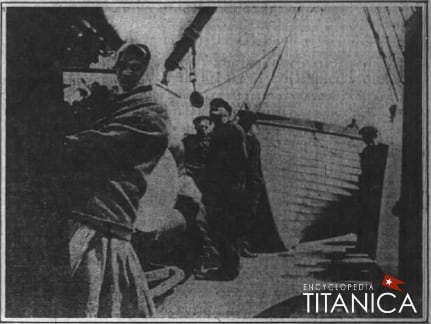
(Indianapolis News, Saturday, April 20, 1912)
By 7:40 pm the Carpathia reached Quarantine, and by 7:50 pm the ship was seen steaming past the Statue of Liberty. The Carpathia, once arriving at the piers, would overshoot the Cunard's pier and steam up to pier 60, where it turned to port and stopped mid-river. The newspaper The Times-Dispatch would write of the scene:
The steamship was off her pier at 9 o'clock, and though many on the pier could not see her, they knew she was there, and the worst period of waiting of the whole night began as the Carpathia lingered in midstream to drop the Titanic's lifeboats that they might be lowered to the White Star pier.
The ports in the big inclosed [sic] pier of the Cunard Line were opened and through them the waiting hundred almost frantic with anxiety over what the Carpathia might reveal, watched her as with nerve-destroying leisure she swung about in the river, dropping overboard the Titanic's lifeboats. It was dark in the river, but the lowering of the boats could be seen from the Carpathia's pier and a deep sigh arose from the multitude there as they caught this first glimpse of something associated with the Titanic.
Captain Rostron would explain, "There were dozens of tugs dodging about the ship [Carpathia], and the lowering away of the Titanic's boats (we could not get into dock until all the Titanic's boats were away from the ship, as seven of them were suspended in our davits and six were on the forecastle head, and so in the way of working the mooring ropes), and these boats leaving the ship in the blackness of the night with two of the rescued crew in each boat and some of the Titanic's officers in charge of them, it brought back to one's mind the manner in which these same boats were last lowered from that great and magnificent ship never to reach New York."
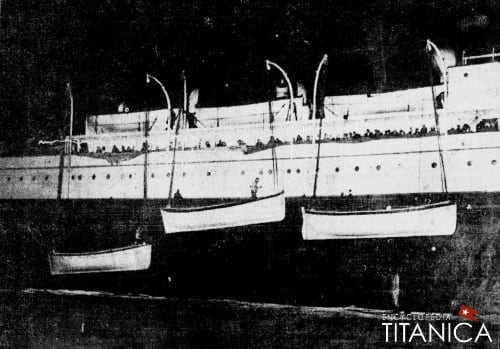
(New York Tribune; Friday, April 19, 1912)

(The Sun; Friday, April 19, 1912)
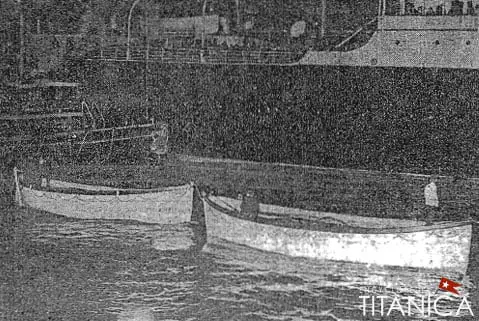
(The New York Times; Friday, April 19, 1912)
Again The Times-Dispatch would relay, "The Carpathia was off the end of the pier ready to dock at five minutes to 9 o'clock. The pilot of a tugboat engaged to assist in warping her in announced that she could not dock until the lifeboats were taken off."
The New-York Tribune explained what happened to the boats once lowered from Carpathia, "While the army of Cunard tugs was warping her into her pier which she had overshot in her grim eagerness, the lifeboats in which she found the Titanic's survivors on Monday morning were lowered over her side. Four of them found rest on a derrick boat alongside. Two others remained across the forward hatch of the liner. Four others, apparently in better condition, were towed away to a quiet berth."
A reporter from The Washington Herald did not see a fourth boat but noticed, "Trailing in the wake of the Carpathia was a tugboat with three of the Titanic's lifeboats in tow." Another reporter would merely write that, "The boats were dropped from the Carpathia before she entered her dock and were carried by tugs to the White Star line piers."

(The Philadelphia Inquirer; April 21, 1912)
It was sometime between 9:10pm and 9:30pm that Carpathia finally moored at pier 56. Shortly, no later than 9:40pm, a gangplank was laid, and survivors began to disembark while Franklin quickly boarded the vessel and found Ismay. Another person who wanted to speak to Ismay was Republican Senator William Alden Smith, who was to head the US Senate Inquiry into the disaster. Smith and his posse had originally planned to board the ship before it docked. However, they did not make it in time to do so, as noted:
In addition a cutter was in readiness, with an officer in charge, to meet the train from Washington conveying the congressional committee for the purpose of escorting them down the harbor to meet the Carpathia. The train, however, did not arrive in Jersey City until about the time the Carpathia docked. The committee, therefore, did not avail themselves of the services of the cutter, but went directly aboard the steamship found fast to her dock.
Once aboard, Smith would conduct a closed-door interview with Ismay for about a half hour. Emerging from behind the closed door, Smith stated that Ismay's story was 'very, very interesting,' while also stating, "All the lifeboats that were used to rescue those few of the Titanic passengers who did survive have been saved, brought here on board the same steamer that brought the survivors, and will be used by the Senate Investigating committee."

(Harper's Weekly, Vol. 56; 1912)
By the time dock superintendent, Osborne B. Thompson made his way onto pier 59, he had missed the Carpathia dropping Titanic's lifeboats, though he supposed this was done at the pier. He would recall how he, "By the Merritt & Chapman derrick Champion," received 13 lifeboats, "… 11 large boats and 2 small ones… In the night time after the Carpathia docked…," and that the boats, "…were put in the water for the night…"
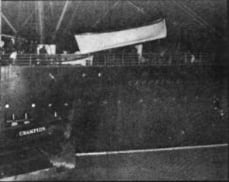
(Leslie's Illustrated Weekly, Vol. CXIV, 1912)
The following day a reporter would inquire Captain Rostron about the lifeboats, reporting, "Asked about the lifeboats, Capt. Rostrum [sic] said he found one among the wreckage in the sea. Several of the lifeboats brought in on the Carpathia to New York, he said, were lowered last night and hauled away by tenders, he knew not where."
On April 17th, a Postmaster by the name of Campbell sent the following telegram, "Full mails for Europe will close at this (New York) office, Thursday, April 18, at 12 o'clock midnight, to go forward by the S.S. Lapland, instead of the S.S. Titanic, sailing from New York city, Saturday, April 20th." This would not be the only role the Lapland would hold within the Titanic's story, for as reported, "New York, April 20 - Most of the surviving crew of the Titanic sailed today for Plymouth, England, on the Lapland. Several members did not report when the ship left, and fourteen, among whom there are four officers, are being held by orders of the Senate investigating committee. All of the twenty stewardesses went on the ship."
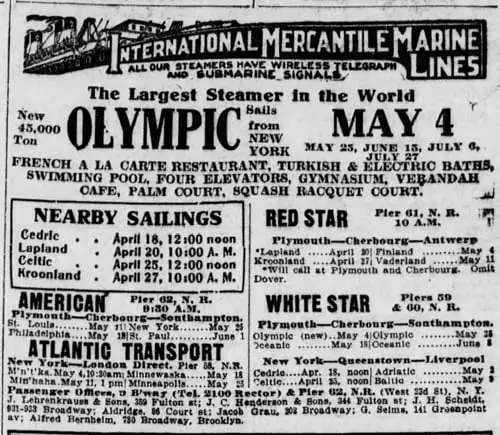
(The Brooklyn Daily Eagle; Wednesday, April 17, 1912)
The Lapland belonged to the Red Star Line, which, like the White Star Line, was part of the IMM. As such, the Lapland would use the piers designated to the IMM (58-62), with the Red Star Line being given pier 61. The above article would continue by stating, "On the pier adjoining the one from which the Lapland sailed lay lifeboats of the Titanic in which the survivors were taken to the Carpathia."
Being that the Lapland was docked at pier 61, the previous article implies that the boats were lined up between piers 59 and 60. However, this was not the case. Thompson would recall that the boats, having spent the night of the 18th on the water, were "…taken on the loft the next morning" by the Merritt & Chapman men, who brought their derrick to the dock, while he watched, 'superintending it'. He would further explain that the boats were put in 'the loft between pier 58 and 59." This location would later be verified by surveyor Frank Martin (whose inspection of the boats will be discussed later) when he explained, "The boats we examined were placed on the upper deck of the dock… They were lying on pier 58, North River."
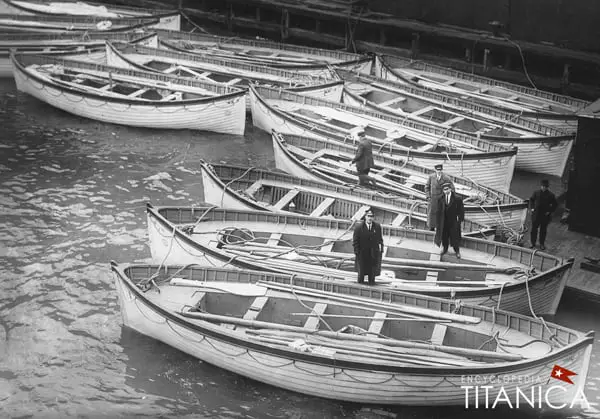
(Sinking of the Titanic; Jay Mowbray; The Minter Co.; 1912)
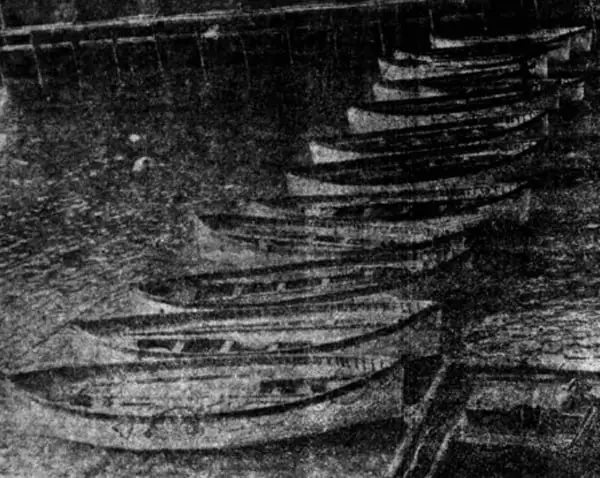
(The Daily Herald; May 3, 1912)
As soon as the boats were put in the loft, Thompson would make an inventory of all the boats and all their content, with a clerk writing down the different articles, while other men, under Thompson's supervision, put the loose items (minus the oars, sails and rudders) in 'the locker' at the sail-makers' loft on the lower outside end of pier 59. Once Thompson's list was completed, it was taken to a stenographer who, while Thompson 'sat alongside him,' typed out a duplication of the list.
Thompson, based on the assumption that all the boats were furnished the same, also noted in his list whether the boats were missing any of their plates (name, number, register and draft) or White Star Line flags. He would recall that the name Titanic was 'written on [a] board' made of wood, and that it was 'carved on the name plate.' He would notice that 'the name was still on' some of the boats, though 'not quite sure about all' of them, though he was certain the inventory sheet he made showed, "…plainly whether they are missing or whether they are on there."
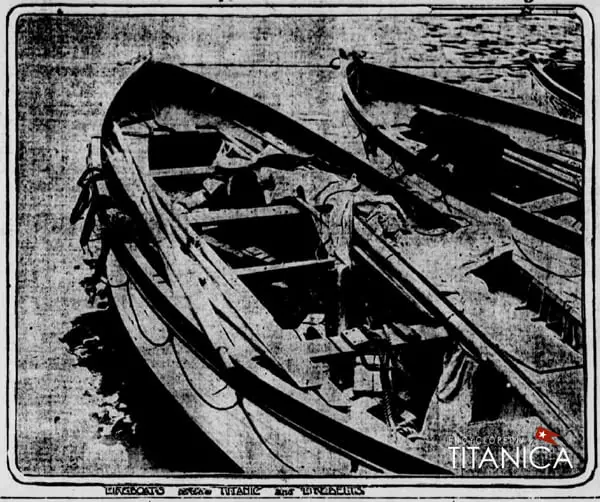
(The Evening World; Saturday, April 20, 1912)
The reference to missing items has led to speculation that souvenir hunters ravaged the boats during the night of April 18th; however, any looting, if it occurred, was never reported. It is also equally plausible that they had fallen or broken off during the handling of the boats. History does, however, allow the tracing of some of these missing articles.
One such example being the story of Able Seaman Thomas Jones, in charge of lifeboat 8. He would later send first class passenger The Countess of Rothes, who worked the tiller of lifeboat 8 and was, as he proclaimed, 'more of a man than any' he had on board his lifeboat that night, a plaque with the number plate of lifeboat 8 attached. In a letter accompanying the plaque, he would write:
My Lady,
I beg to ask your acceptance of the number of my boat from which you were taken on board SS Carpathia.
This number is the original taken from the boat by myself. In asking you to accept the same I do so in respect for your courage under so terrifying circumstances.
Trusting you are now fully recovered to health, I am, Your obedient servant, Tom Jones AB Late SS Titanic.
Titanic survivor Abraham Salomon would relate, "Within an hour after the Titanic's lifeboats had been stowed aboard the Carpathia every name plate had been taken off them. They were offered for sale at $5 each, and every one of them was sold. That doesn't seem to me a very commendable proceeding from either side, but I may be wrong."

(Courtesy of the State Library of Queensland)
The placing of the boats into the loft did not go unnoticed by the media, who would declare, rather conspiratorially, that the White Star Line was secretively hiding the boats away from the public, with one publication asking, "What was wrong with such lifeboats as there were to make the White Star hide after they were brought to New York by the Carpathia." Some of these articles would also announce that a photographer was shot at, as noted below:
Lifeboats Secreted - Photographer Says Shot Was Fired
The lifeboats of the Titanic which were brought here by the Carpathia have been carefully secreted by the White Star officials. A man who went out on a launch to photograph these boats in the slip in the North river where they are held alleged that he was shot at by a pier watchman after he refused to leave the vicinity.
The sinking of the Titanic would lead to a public outcry for 'lifeboats for all', and the shipping companies, with their knee-jerk reaction, scrambled to fit their ships with sufficient lifeboats, and orders for lifeboats grew exponentially as reported, "The Press Association's Liverpool correspondent telegraphs - The effect of the criticisms as to the inadequacy of the boats carried by big liners has led to an extraordinary boom in the building of lifeboats. In Liverpool during the past two or three days orders have poured in to boat builders from all the leading steamship companies in Liverpool, and day and night shifts are arranged in order to cope with the demand. None of the builders had any surplus stock…
It was further stated, "Shipbuilding firms are overloaded with sudden orders for lifeboats from all sides and are unable to supply the demand." Another article, under the headline "New York Builders Swamped With Orders From Lines" reads:
Since the White Star liner Titanic sank on April 15 all lifeboats and liferafts [sic] in stock in the city have been sold and the builders have been flooded with orders for more.
There are only two companies in this port that make lifeboats, one in Front Street and another with a plant at Hunter's Point. As soon as it became known that the great loss of life on the Titanic was due almost entirely to the inadequate supply of lifeboats steamship owners in this city put in orders for all the boats the two firms had in stock.
…
The builders have doubled their force of workmen and have placed large orders for the material used in construction. As lifeboats can be purchased cheaper abroad it is thought the foreign steamship lines will take on all their equipment at home ports.

(Popular Mechanics; July 1912)
By April 19th, the Allan Line declared that they were going to increase their lifeboats, while the Booth Line stated, "...it is impossible to fit up steamships with an unlimited number of boats," and instead suggested to, "…restrict the number of passengers carried to the accommodations in the lifeboats." The following day, April 20th, the Hamburg-American Line announced that they would increase the number of lifeboats on their steamers. Meanwhile, North German Lloyd Line sent a cable to 'Bremen for instructions', as that is where their ships were fitted out. They expected a reply by the 23rd.
The Mauretania arrived in New York On Friday, April 19th, with not only a duplicate manifest of Titanic's freight cargo within its registered mail but with the chairman of the Cunard Line aboard. Upon his arrival, he would cable the Cunard offices in Liverpool, via Cape Race, to "Prepare plans for fitting all steamships with life rafts or collapsible boats to full numbers required." With the Mauretania set to sail again on the 24th, it was a mad race to get enough lifeboats in time aboard. By the 23rd, they had been successful "…in getting seven liferafts of the catamaran type, approved by the United States Government, and eight lifeboats of the regulation sort."
It was reported the following day that "The lifeboats and rafts ordered yesterday of which only one lifeboat and five rafts had arrived late yesterday afternoon, were all put aboard in time for sailing, and the Mauretania went out fully equipped."
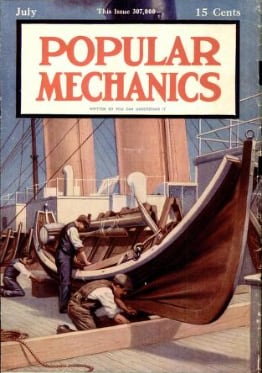
(Popular Mechanics; July 1912)
On Monday, April 22nd, Franklin would tell the US Senate Inquiry that "…since the accident to the Titanic we have been absolutely overwhelmed, first in distress matters, to do everything we could for everybody, and the only precaution or action that we have taken is that Mr. Ismay authorized, last Friday, and instructed the managers abroad to immediately equip all of the I.M.M. Co.'s steamers with lifeboats and life rafts enough to carry every passenger and every member of the crew. Further than that we have not gone."
Ismay himself would make the following statement:
Everybody learns by experience. One thing I learned from my experience is that the laws relating to the preservation of life in case of just such an accident are not adequate. They were based, no doubt, upon the assumption that these great steel ocean liners were unsinkable, with their highly developed system of bulkheads. But experience has taught us that in certain circumstances there are at present no such things as unsinkable ships.
I issued this order as a result of my own observations. I am candid to admit that until I had had actual experience in a wreck I never fully realized the inadequacy of the rules of our and other lines with reference to the preservation of life in case of an accident in midocean. I had gone along like the rest of the steamship men on the theory that our ships were unsinkable.

(The Literary Digest; June 22nd, 1912)
On the 21st, a headline would declare, "More Boats For Olympic" with the report saying, "The White Star Line has arranged to place aboard the Olympic on the next voyage sufficient canvas boats and boat-rafts to accommodate all on board."
Another article would speak of not only the Olympic, saying, "The Olympic has been provided with forty collapsible boats and will carry sixteen additional lifeboats," but would also speak of the third Olympic Class liner, saying, "It is understood that the plans of the White Star liner Gigantic, which is now being built at Belfast and which was to have been 1,000 feet in length, will be modified…."
On April 22nd, it was stated that "The Olympic, sister ship of the lost Titanic, will carry 40 additional lifeboats when she leaves Southampton for New York Wednesday. Boats ordered today." Some of the boats having been ordered were "…the sixteen new lifeboats ordered for Olympic from Messrs. Harland & Wolff," which would accommodate 65 persons each, for a total of 1,040.
By the next day, "…thirty-five additional collapsible boats arrived abord this afternoon, and five more are expected." These collapsible boats were said to have "…been taken off British troopships plying between England and India and South Africa. The season of transportation of troops now being over… the White Star Line had bought all the second-hand collapsible boats that could be found."
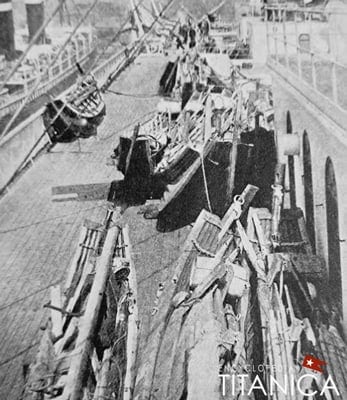
(The Literary Digest; June 22nd, 1912)
Twenty minutes before the Olympic was set to sail on April 24th, a group of stokers and greasers abandoned ship declaring, "…that the forty collapsible boats taken from troopships in the harbor were rotten and unseaworthy and would not open." It was further stated that "…the firemen and oilers simply followed out a threat they made at Cherbourg last Saturday when the Olympic reached there at the end of a voyage made harrowing by the wireless reports of the sinking of the Titanic."
To combat this mutiny, "…a request was sent to Mr. Curry, the Southampton manager of the White Star Line, that all the collapsible boats be replaced by wooden lifeboats. Mr. Curry replied that this was impossible and told the men the boats had been passed by a Board of Trade Inspector."
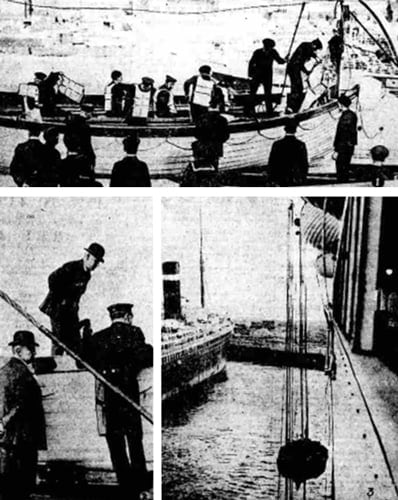
(Belfast Evening Telegraph, Saturday; April 27, 1912)
On the 24th it was reported that, "Harland & Wolff have dispatched thirty-two lifeboats, each with a capacity of sixty-five persons, to Liverpool," and that, "It is reported that the boats are for the Olympic, which is to proceed to the Mersey to receive them." This was subsequently repeated, "A Belfast telegram states that it is learned from a trustworthy source that thirty-two lifeboats, each accommodating sixty-five persons, have been forwarded by Harland & Wolff to Liverpool for the Olympic, which, it was understood, will proceed to Liverpool to take them aboard."
It was stated of the origins of these boats, "- Harland & Wolff the builders of the Titanic, shipped thirty-two lifeboats to Liverpool to-day. It is understood they are intended for the Olympic, which will go to that port to get them before sailing for New York. The lifeboats were taken from vessels which are now undergoing equipment at the Harland & Wolff yard."
The Scottish newspaper Evening Telegraph and Post would further elaborate on the 25th that, "Messrs. Harland & Wolff shipped last night to Liverpool 32 lifeboats, which, it is understood, are intended for the Olympic… The Olympic will go round to Liverpool for the purpose of taking the lifeboats aboard.
"It was only possible to supply the boats by taking them from vessels which are being fitted out in the shipyard of Messrs. Harland & Wolff." However, Olympic ever heading to Liverpool to receive any lifeboats is not supported within the historical records. Thus, if such boats were meant for Olympic, Olympic never went to Liverpool to receive them.
The Olympic eventually did resume its voyage on May 15th, with not only enough lifeboats but also leading fireman Fredrick Barrett who had survived the sinking of the Titanic. Originally it was reported that once the Olympic reached New York on May 4th (the original arrival date before it was delayed due to the deserting crew) that, "The Olympic will take aboard at New York the lifeboats of the Titanic, which are now there." When the Olympic finally did arrive on May 22nd, this, however, was not done.
Besides the fact that Senator Smith had declared his want to use the boats during his investigation (which concluded on May 25th), the lifeboats were probably kept in New York due to the growing liability claims brought against the White Star Line. The White Star Line would file to limit their obligation of liability. This limitation of liability differed between Britain and the US, as explained:
These proceedings may be instituted either in England or in the United States. If they are instituted in England the White Star Line will be obliged to admit liability for the accident and pay into the registry of court for distribution among the complainants £15 per registered ton in the case of loss of life and personal injury claims and £8 per registered ton in respect to claims for damages to cargo, etc.
…
Having regard to the enormous tonnage of the Titanic, the amount to be deposited by the White Star Line in connection with limitation proceedings in England would far exceed the amount which it would be necessary to pay into the United States courts if the proceedings were instituted here. Under the American limitation of liability act of 1851 it is provided that when the loss occurs without the knowledge or privity of the owner the liability shall be limited to the value of the vessel after the wreck - in this instance nil - plus pending freight (freight cargo and all passage money)…
Being that the limitation of liability in Britain had no attachment to any salvaged items and was based solely on tonnage, there was no legal requirement for the White Star Line to bring these boats back to England. However, given that they would be used (though the above article read that 'the value of the vessel after the wreck' was 'nil'), in the Limitation of Liability hearings in the US, as salvaged articles from the ship, in order to access the White Star Line's, "…interest in the steamship Titanic and her pending freight as of April 15, 1912," the White Star Line would have to leave the boats in the US. In fact, the court filings for the limitation of liability case would clearly state, "…said boats being at the time of the filing of said petition within the Southern District of New York and within the jurisdiction of this court."
The Olympic arrived in New York for the final time in 1912, on September 26th. After steaming back to England, it would then travel to Harland & Wolff shipyard (arriving October 10th) to be retrofitted with updated safety features. It was written, "The principle alternation is the construction of a second, or inner, hull 3ft. from the hull proper, and rising well above the water-line to the main deck. Four additional bulkheads have also been introduced, nineteen more lifeboats provided on davits…." The Olympic would be put back into service on April 2nd, 1913.
To replace the Titanic in its Southampton to New York route, the White Star appointed the Majestic. Its first appearance in New York after taking over was on May 30th, 1912. By September 1st, it was shown that the Majestic, too, had received a full complement of lifeboats.

(The Sun; September 1, 1912)
On May 13th, the White Star Line's offices would receive a Marconigram reporting that in 'latitude 30.56, longitude 47.01' their steamship Oceanic, had, "…picked up a collapsible boat of the Titanic containing three bodies. One body was apparently that of Thomas Beattie, and the other were a sailor and a fireman. They were committed to the deep. In the boat were also a coat with letters addressed to Richard N. Williams, a cane marked Dan Williams, and a ring which the inscription Edward and Gerda."
The Evening World would describe the finding of the boat:
Two miles off the port bow a gray (boat?) rolled in and out of sight on the crest of the long blue rollers and into their hollows. Mr. Frank [author's note: Oceanic's First Officer] caught up his glasses. What he saw caused him to send a quartermaster for the Captain in a hurry.
There were three bodies on the boat. One was huddled forward with an (arm?) and the head hanging over the edge. The other two mere sprawled (across?) the thwarts aft.
A boat was put overboard in command of Third Officer Withers. Six men pulled at the oars. The passengers of the liner, which had been stopped, knew its errand. They knew that, past all hoping of anything different, the men in the collapsible were dead. They watched the boat go over the sparkling (?). They saw it stop for awhile beside the gray flat thing in the water. Then it turned and came back.
Mr. Withers climbed the boarding ladder. Passengers crowed to him with hoarsely whispered questions. His face was set. His eyes were narrowed. He shook his head sternly and, silent, hurried quickly to the bridge.
The ship's surgeon, Dr. R.S. French, was summoned by the captain. A fresh crew was put in the boat. Dr. French went into the stern seat and again the boat went out to the bobbing raft.
…
They saw, those who had strong glasses, that he and his men were busy with the bodies in the boat. They saw great sheets of canvas flash and saw the bodies wrapped in them. Then they saw the surgeon rise and, supported on either side, hold a book before him. They could not see his lips move, but they knew he was reading the beautiful Episcopal services of the burial of the dead, with the variations for those who are lowered into the ocean - we commit these bodies to the sea"
There were three splashes. The Oceanic boat came slowly back with the Titanic boat zigzagging behind it and the two were hoisted to place on deck. The boat's crew went back to their quarters and Dr. French went to the captain. The Oceanic went on her way.
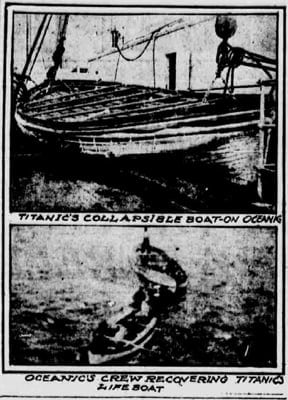
(The Evening World, Thursday; May 16, 1912)
When the Oceanic arrived in New York on May 16th, 1912, Osborne Thompson would recall that subsequently, "We received a collapsible boat, picked up by the Oceanic… In the middle of May, sometime." Once recovered, it was 'placed with the others.' He would observe that the boat 'didn't have any gear' and 'was in a broken condition', noting, "Where the collapsible frame comes on the top of the solid part, that bulwark-like was all carried away - [it] was split." He would also state that he did not notice anything to indicate that it was from the Titanic.
As history would prove, the boat itself would turn out to be collapsible A, the improperly launched collapsible that partly flooded. Though it is believed that around thirty or so people clambered onto the boat, either before or after it floated off Titanic, only around a dozen or so would survive the night - having stood for several hours in freezing water up to their knees. They would eventually be taken aboard lifeboat 14, under the command of Fifth Officer Lowe.
Having filed to limit their liability, the White Star Line hired Frank S. Martin and Henry Masters to look over the boats and assess their value. Martin, of Office 52 Beaver Street, had been a surveyor for thirty-two years. Masters, of 15 Whitehall St., had twelve years of business in New York and would state, "I do all of Merritt & Chapman's valuations." Their survey would take place on September 28, 1912.
Martin would recall that once they reached the dock, "We saw the dock superintended and he turned us over to the dock carpenter and assistant...." He would state that the boats 'were lying on pier 58, North River' and that "The boats we examined were placed on the upper deck of the dock - the second story, but were not in order according to their number. We started in at one end of the dock and took the boat that happened to be there and the first one was No. 11."
Both the dock carpenter and assistant '…helped remove the canvas and held the line while we measured them," Martin continued. Masters recalled that the Carpenter and himself made the measurements while Martin "…put them down as we read them off to him." Martin would concur saying, "I made the notes in my book."
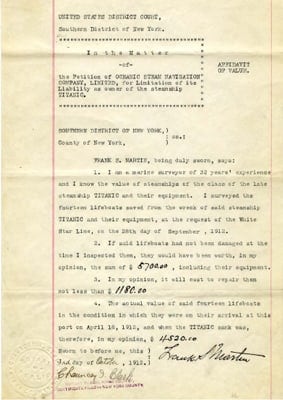
(Limitation of Liability Hearings, United States National Archives)
Masters would also recall that the superintendent had told them that the boats were from the Titanic but did not recall any letters showing that they were from Titanic, nor anything else to confirm the superintendent's statement. Martin would also recall being told the boats were from Titanic, but remember somewhat differently that "You could see the name on the side of the boats, although the name in some places, the name plate had been taken off and the numbers had been taken off by the marks from the letters were still on the boat where the enameled letter had been."

(Limitation of Liability Hearings, United States National Archives)
Both Martin and Masters would state that each boat was examined separately. Master would remember that the boats looked 'comparatively new' while Martin would say, "They didn't appear to be very old. I couldn't tell absolutely, but they didn't appear to be very old." He would elaborate, "They were all more or less damaged; some of the planks were broken, and they were all chafed. Some of them had the gunwale molding torn off."
Martin would say that the examination took a better part of the day, while Masters would be more precise, saying, "It took several hours - 4 or 5 hours, I suppose." Both men would come to agreement on the value of the boats based on their value in Britain. Called before the court on October 3rd, 1912, both men would sign an 'Affidavit of Value' placing the value of the lifeboats (had they not been damaged) and equipment at $5,700, with the cost of repairs being $1,180, which gave a total value of them, as they were, of $4,520.
On December 20th, 1912, the court would call Axel Sawman, who, for the past year, had been working as secretary and treasurer of the C.M. Lane Lifeboat Co., and previously was employed in the lifeboat business for the Weith Lane, DeGroot Co. of Long Island. He had, at the request of White Star Line's superintendant, Captain Smith, went a 'few days' previous to look over the boats which were, "At the White Star Line pier, North River…. In the upper part of the shed."
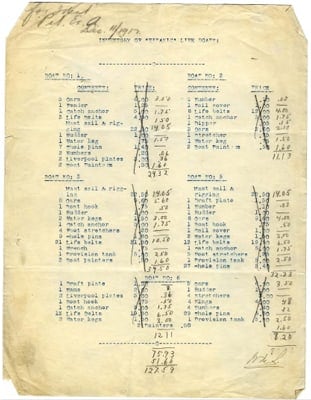
(Limitation of Liability Hearings, United States National Archives)
While there he "…examined the articles and made an appraisal of them…. I went over the articles, each articles… These articles were mostly inside the boats. In each lifeboat were oars and boat hooks and such articles. They were right inside the boats… There were a few articles such as sails and minor smaller articles, they were in a bag in the sail locker on the same pier but not actually in the boats."
Unlike Masters and Martine, Sawman would value the items, "…the prices in the American market." When his list was presented into evidence on January 9, 1913 his value of the lifeboats was $4,972, with the value of the equipment being $474.31.
As far as history has it, Sawman is the last person known to have seen Titanic's lifeboats. What occurred to them after that December day is unknown. Were the boats sold or auctioned off? Were they scrapped? Did the White Star or another company repair the boats and reuse them? As of now, history has no answer, and it is with these boats that the story of Titanic's last remaining remnants comes to an end.
Bibliography
Additional Sources
http://www.bradmpayne.com/
https://archive.nytimes.com/www.nytimes.com/ref/membercenter/nytarchive.html
https://www.newspapers.com/
Scribner's Magazine, Vol. 53; March 1913

Comment and discuss